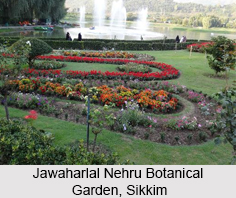 Jawaharlal Nehru Botanical Garden is a lush green expanse of land that enchants visitors with its serene beauty in Sikkim. Located near Rumtek Monastery on the highway, the Garden encompasses rare plants, trees and numerous species of flowers including Orchids of Himalayan region. This verdant green patch of land is maintained by the Forest Department of the Government of Sikkim under its unit of Parks and Gardens.
Jawaharlal Nehru Botanical Garden is a lush green expanse of land that enchants visitors with its serene beauty in Sikkim. Located near Rumtek Monastery on the highway, the Garden encompasses rare plants, trees and numerous species of flowers including Orchids of Himalayan region. This verdant green patch of land is maintained by the Forest Department of the Government of Sikkim under its unit of Parks and Gardens.
Established in 1987, Jawaharlal Nehru Botanical Garden embraces several varieties of botanical species. Jawaharlal Nehru Botanical Garden includes dense temperate forests of Oak too. It has not less than 50 different varieties of tree species. The wide range of plants and flowers is often regarded as the result of variation of altitude from 1800m to 2200m. The Garden is a concoction of well-nursed tropical and temperate plants.
Amenities in Jawaharlal Nehru Botanical Garden
A huge greenhouse has been erected in the Jawaharlal Nehru Botanical Garden, where different varieties of Orchids are grown. With the intention of merriment for children, a small recreational area has been made in the company of merry-go-round, swings and see-saw. There are several gardens within the Jawaharlal Nehru Botanical Garden along with some enchanting water fall which add up to the beauty of Himalayan flora sprawled across the Jawaharlal Nehru Botanical Garden. In the mountainous region of Sikkim, Jawaharlal Nehru Botanical Garden is certainly a relishing treat for plant lovers. In general terms, the garden has been able to retain the position of an ideal picnic spot.
A concrete pavement across the garden leads to the hidden areas of the park and assures a stress-free saunter. The best time to visit this garden is between the months of March to late May and from October to Mid-December.
Visiting Information of Jawaharlal Nehru Botanical Garden
Being close to the Rumtek Monastery, the Jawaharlal Nehru Botanical Garden in Sikkim can be easily approached from Gangtok, the capital city of Sikkim. The nearest airport is Bagdogra and the nearest railway stations are Siliguri or New Jalpaiguri and the road transport is possible from Gangtok. Private Taxis, Jeeps and Land-rovers ply regularly on the Gangtok-Siliguri Highway.



















